Contents
| Part of a series on the |
| History of Canada |
|---|
 |
Research |
Events from the 1680s in Canada.
| Part of a series on the |
| History of Canada |
|---|
 |
Events from the 1680s in Canada.

France began colonizing the Americas in the 16th century and continued into the following centuries as it established a colonial empire in the Western Hemisphere. France established colonies in much of eastern North America, on several Caribbean islands, and in South America. Most colonies were developed to export products such as fish, rice, sugar, and furs.

René-Robert Cavelier, Sieur de La Salle, was a 17th-century French explorer and fur trader in North America. He explored the Great Lakes region of the United States and Canada, and the Mississippi River. He is best known for an early 1682 expedition in which he canoed the lower Mississippi River from the mouth of the Illinois River to the Gulf of Mexico; there, on 9 April 1682, he claimed the Mississippi River basin for France after giving it the name La Louisiane. One source states that "he acquired for France the most fertile half of the North American continent". A later ill-fated expedition to the Gulf coast of Mexico gave the United States a claim to Texas in the purchase of the Louisiana Territory from France in 1803. La Salle was assassinated in 1687 during that expedition.

King William's War was the North American theater of the Nine Years' War (1688–1697), also known as the War of the Grand Alliance or the War of the League of Augsburg. It was the first of six colonial wars fought between New France and New England along with their respective Native allies before France ceded its remaining mainland territories in North America east of the Mississippi River in 1763.
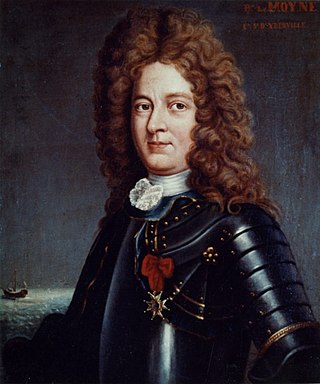
Pierre Le Moyne d'Iberville or Sieur d'Iberville was a French soldier, explorer, colonial administrator, and trader. He is noted for founding the colony of Louisiana in New France. He was born in Montreal to French colonist parents.

Louis de Buade, Comte de Frontenac et de Palluau was a French soldier, courtier, and Governor General of New France in North America from 1672 to 1682, and again from 1689 to his death in 1698. He established a number of Forts on the Great Lakes and engaged in a series of battles against the English and the Iroquois.

Henri de Tonti, also spelled Henri de Tonty, was an Italian-born French military officer, explorer, and voyageur who assisted René-Robert Cavelier, Sieur de La Salle, with North American exploration and colonization from 1678 to 1686. de Tonti was one of the first explorers to navigate and sail the upper Great Lakes. He also sailed the Illinois and the Mississippi, to its mouth and thereupon claimed the length of the Mississippi for Louis XIV of France. He is credited with founding the settlement that would become Peoria, Illinois. De Tonti established the first permanent European settlement in the lower Mississippi valley, known as Poste de Arkansea, making him "The Father of Arkansas".

This section of the Timeline of Quebec history concerns the events relating to the Quebec portion of New France between the establishment of the Sovereign Council and the fall of Quebec.
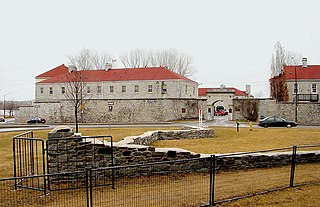
Fort Frontenac was a French trading post and military fort built in July 1673 at the mouth of the Cataraqui River where the St. Lawrence River leaves Lake Ontario, in a location traditionally known as Cataraqui. It is the present-day location of Kingston, Ontario, Canada. The original fort, a crude, wooden palisade structure, was called Fort Cataraqui but was later named for Louis de Buade de Frontenac, Governor of New France who was responsible for building the fort. It was abandoned and razed in 1689, then rebuilt in 1695.

Jacques-René de Brisay, Marquis de Denonville was the Governor General of New France from 1685 to 1689 and was an important figure during the intermittent conflict between New France and the Iroquois known as the Beaver Wars.

Lachine is a borough (arrondissement) within the city of Montreal on the Island of Montreal in southwestern Quebec, Canada.
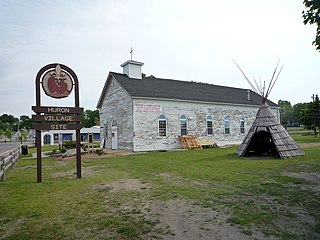
Fort de Buade was a French fort in the present U.S. state of Michigan's Upper Peninsula across the Straits of Mackinac from the northern tip of lower Michigan's "mitten". It was garrisoned between 1683 and 1701. The city of St. Ignace developed at the site, which also had the historic St. Ignace Mission founded by Jesuits. The fort was named after New France's governor at the time, Louis de Buade de Frontenac.

The Schenectady massacre was an attack against the colonial settlement of Schenectady in the English Province of New York on February 8, 1690. A raiding party of 114 French soldiers and militiamen, accompanied by 96 allied Mohawk and Algonquin warriors, attacked the unguarded community, destroying most of the homes, and killing or capturing most of its inhabitants. Sixty residents were killed, including 11 Black slaves. About 60 residents were spared, including 20 Mohawk.
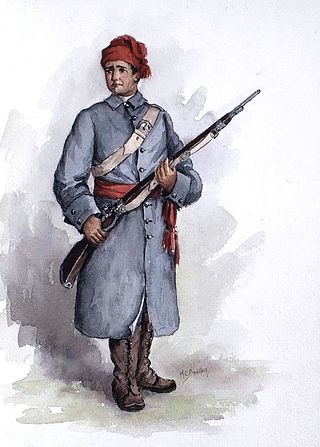
The military of New France consisted of a mix of regular forces from the French Royal Army and French Navy supported by small local volunteer militia units. Most early troops were sent from France, but localization after the growth of the colony meant that, by the 1690s, many were volunteers from the settlers of New France, and by the 1750s most troops were descendants of the original French inhabitants. Additionally, many of the early troops and officers who were born in France remained in the colony after their service ended, contributing to generational service and a military elite. The French built a series of forts from Newfoundland to Louisiana during the 1600s to the late 1700s. Some were a mix of military posts and trading forts.

The Lachine massacre, part of the Beaver Wars, occurred when 1,500 Mohawk warriors launched a surprise attack against the small settlement of Lachine, New France, at the upper end of Montreal Island, on the morning of 5 August 1689.
Jean Bochart de Champigny, Sieur de Noroy et de Verneuil, was Intendant of New France from 1686 to 1702. His mandate was one of the longest, rivalling those of Hocquart and Bégon. He served as intendant during the terms of Governors Denonville, Frontenac, and Callière, and was in office at the time of King William's War, the Lachine Massacre, the Battle of Quebec, and the Great Peace of Montreal.
The timeline of Montreal history is a chronology of significant events in the history of Montreal, Canada's second-most populated city, with about 3.5 million residents in 2018, and the fourth-largest French-speaking city in the world.

The Pays d'en Haut was a territory of New France covering the regions of North America located west of Montreal. The vast territory included most of the Great Lakes region, expanding west and south over time into the North American continent as the French had explored. The Pays d'en Haut was established in 1610 and depended on the colony of Canada until 1763, when the Treaty of Paris ended New France, and both were ceded to the British as the Province of Quebec.
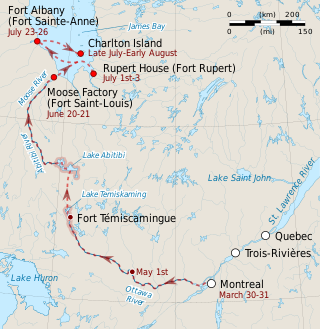
The Hudson Bay expedition of 1686 was one of the Anglo-French conflicts on Hudson Bay. It was the first of several expeditions sent from New France against the trading outposts of the Hudson's Bay Company in the southern reaches of Hudson Bay. Led by the Chevalier de Troyes, the expedition captured the outposts at Moose Factory, Rupert House, Fort Albany, and the company ship Craven.

Kondiaronk, known as Le Rat, was Chief of the Native American Wendat people at Michilimackinac in New France. As a result of an Iroquois attack and dispersal of the Hurons in 1649, the latter settled in Michilimackinac. The Michilimackinac area is the strait between Lakes Huron and Michigan in the present-day United States.
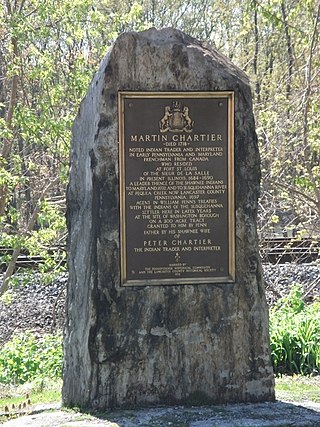
Martin Chartier was a French-Canadian explorer and trader, carpenter and glove maker. He lived much of his life amongst the Shawnee Native Americans in what is now the United States.